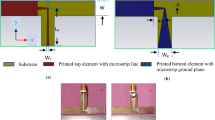Abstract
Source-antenna transition modeling differential feed of microstrip center-feed bi-plane printed dipole antenna is presented. Design considerations are focused on the feed mode of the studied antenna at its center by the means of ideal plane parallel-plate microstrip transmission line that supports a quasi-TEM mode of propagation. Numerical experiments of the excitation gap effects on the antenna peak resonant resistance were carried out. The calculations of the antenna input impedance using voltage and current wave formalism and the radiated field pattern using retarded potential approach for a given current distribution are performed. It is concluded that bi-plane printed dipole antenna exhibits excellent directional performances such as good selectivity, HPBW of 60° and large band-width of 22%.










Similar content being viewed by others
References
Balanis, C. A. (2016). Antenna theory analysis and design. New York: Wiley.
Picon, O., et al. (2009). Les Antennes. Théorie, conception et applications. Paris: Dunod.
James, J. R., Hall, P. S., & Wood, C. (1981). Microstrip antenna theory and design., IEE electromagnetic waves series 12 London: Peter Peregrinus Ltd.
Mbinack, C., Tonye, E., & Bajon, D. (2014). Electromagnetic modeling and design principle of parallel plane printed microstrip dipole antennas. Journal of Applied Sciences, 14(18), 2061–2066.
Garg, R., Bahl, I., & Bozzi, M. (2012). Microstrip lines and slotlines. Norwood: Artech House.
Getsinger, W. J. (1983). Circuit duals on planar transmission media. In IEEE MTT-S international microwave symposium digest (pp. 154–156).
Sadiku, M. N. O. (2001). Numerical techiques in electromagnetics. Boca Raton: CRC Press LLC.
Mbinack, C., & Tonye, E. (2016). Numerical calculation and design of variant topologies of printed dipole antenna. International Journal of Science and Research, 5(7), 895–899.
Kuo, L. C., Chuang, H. R., Kan, Y. C., Huang, T. C., & Ko, C. H. (2007). A study of planar printed dipole antennas for wireless communication applications. Journal of Electromagnetic Waves and Applications, 21(5), 637–652.
Acknowledgements
The authors wish to acknowledge Prof Damienne BAJON and Mr Etienne PERRIN from ISAE, Toulouse, France for their significant contributions.
Author information
Authors and Affiliations
Corresponding author
Additional information
Publisher's Note
Springer Nature remains neutral with regard to jurisdictional claims in published maps and institutional affiliations.
Rights and permissions
About this article
Cite this article
Mbinack, C., Tonye, E. Microstrip Center-Fed Bi-plane Printed Dipole Antenna Design and the Excitation Gap Contribution for Impedance Control. Wireless Pers Commun 103, 1713–1724 (2018). https://doi.org/10.1007/s11277-018-5876-1
Published:
Issue Date:
DOI: https://doi.org/10.1007/s11277-018-5876-1




